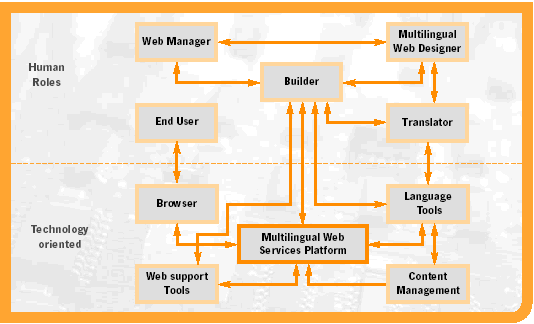|
Roles in multilinguality
When building a Web site, mono or
multilingual, it can be useful to consider it as the composition of a
series of roles. In this context, a ‘role’ is simply a logical
function that interacts with other roles and has an internal coherence of
its own when considered in the global framework. No further commonality
can be found among different roles; in fact it is possible to view roles
to be played by persons (user, designer, etc.) and roles to be played by
technology capabilities (tools, content resources, etc.). The focus here
is much more on the ‘roles’ themselves than on the ‘actors’ (or
the players). This is because actors may perform different roles depending
on various circumstances external to our multilinguality problem domain
(e.g. type of company, size or positioning on the Internet market and
product range or level of coverage for tools). A list of roles has been
identified and their interactions belonging to the multilinguality
framework. Some of these roles are general, but some others are specific
to multilingual Web sites and some others may provide other
functionalities. The following human-related roles are included:
The following
technology-oriented roles are considered in the multilinguality framework:
-
Browser
-
Web support tools
-
Language tools
-
Content management tools
These roles and the relations
between them can be observed in the figure above. A brief explanation of
each role and its relationships with other roles is presented below.
Cited from:
EURESCOM |
